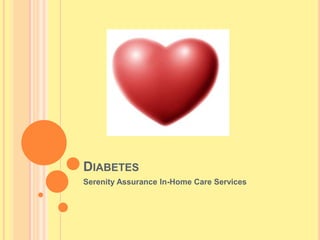
Diabetes Presentation
- 1. DIABETES Serenity Assurance In-Home Care Services
- 2. WHAT IS DIABETES? Diabetes is a defect in the body’s ability to convert glucose (sugar) to energy. Glucose is the main source of fuel for our body. When food is digested it is changed into fats, protein, or carbohydrates. Foods that affect blood sugars are called carbohydrates. Carbohydrates, when digested, change to glucose. Examples of some carbohydrates are: bread, rice, pasta, potatoes, corn, fruit,and milk products. Individuals with diabetes should eat carbohydrates but must do so in moderation. Glucose is then transferred to the blood and is used by the cells for energy. In order for glucose to be transferred from the blood into the cells, the hormone - insulin is needed. Insulin is produced by the beta cells in the pancreas (the organ that produces insulin).
- 3. THERE ARE 2 DIFFERENT TYPES OF DIABETES Type I Diabetes Type II Diabetes Occurs most frequently in Much more common and children and young adults, accounts for 90-95% of all although it can occur at any diabetes. age. Type 2 Diabetes primarily Type 1 diabetes accounts for affects adult, however 5-10% of all diabetes in the recently Type 2 has begun United States. developing in children. There does appear to be a There are strong correlation genetic component to Type between Type 2 diabetes, 1 diabetes, but the cause physical inactivity and has yet to be identified. obesity.
- 4. WHAT ARE THE SYMPTOMS FOR DIABETES? Blurred Visions Symptoms may occur rapidly with Type 1 diabetes; Slow-Healing Cuts however, with Type 2 Erectile Dysfunction diabetes the onset is more insidious and may not be Unusual Thirst noticed. Fatigue Numbness or Tingling If you have more than one of of hands or feet these symptoms you may Frequent Urination want to ask your doctor to test your blood sugar. Rapid Weight Loss (Type 1)
- 5. IF YOU ARE DIAGNOSED WITH DIABETES, WHAT SHOULD YOU DO? Request a referral to a Begin an exercise program certified diabetes educator Decrease portion size and/or a dietitian. Make healthy food choices Obtain a prescription for a Limit your intake of glucometer and testing concentrated sweets supplies. Increase your fiber intake Begin to make life style changes. Test your blood sugar at varying times of the day Get informed. If you have Diabetes, there are many things you can do to help yourself. The amount of self-management you can achieve will affect the quality of life you lead.
- 6. HOW DIABETES DIAGNOSED? The diagnosis of diabetes is made by a simple blood test measuring your blood glucose level. Usually these tests are repeated on a subsequent day to confirm the diagnosis. A diagnosis of diabetes is a frightening and bewildering experience because there is so much information to take in and the diagnosis may come as a shock. People with Type 2 diabetes may hear their condition described as “mild,” but type 2 diabetes is not “mild,” medical condition. Both forms and all stages of diabetes are serious, with many possible complications, including eye, heart, kidney, and nerve damage.
- 7. WHAT IS THE TREATMENT FOR DIABETES? As yet, there is no “cure” for either type of diabetes, although there are many ways of keeping diabetes under control. Diabetes treatments are designed to help the body to control the sugar levels in the blood. Studies have shown that good control of blood sugar is the key to avoiding diabetic complications. • Type 1 diabetes requires insulin. Injected insulin replaces the insulin missing in the body. You will need to learn how to balance your insulin with your food intake and your physical activity. It is important that you work with a diabetes educator and are under the care of a diabetes team, who can assist you in managing your diabetes • Type 2 diabetes treatment will vary dependent on your blood sugar levels. Many patients are counseled to change their lifestyle and lose weight. It is important to work with a diabetes educator and dietitian. Treatment begins with changing certain food choices and beginning an exercise program. See your doctor every three months until your blood sugar is in control, once it’s under control, your numbers and medication regimen should be reviewed every six months.
- 8. WHAT IS GOOD CONTROL? The A1C test provides you and your doctor with an assessment of the overall control of your diabetes. In simple terms, this test measures the sugar coating on red blood cells. The life of a red blood cell is three months, so this test should be done every three to six months to assess your blood sugar control. Your daily blood sugar results will also provide you with helpful information on the impact of foods, physical activity, and medications. Together these tests should help you manage your diabetes. Although you may not feel sick, high blood sugar levels are damaging blood vessels and your organs. Complications of diabetes are preventable if you keep your blood sugar as close to normal as possible. The goal is an A1C level between 6.5% -7%.
- 9. IT IS IMPORTANT TO TAKE CARE OF YOURSELF. BE SURE TO WORK WITH YOUR PHYSICIAN. Yearly •Complete physical exam, foot exam, creatinine, cholesterol, triglycerides, and urine micro albumin test. •You may have electrocardiogram and/or stress test •Dilated eye exam by an ophthalmologist •Referral to a diabetes educator or nutritionist •Referral to smoking cessation program Every 3-6 Months •A1C •A dental exam Each Doctor visits •Weight and blood pressure •Review all medications •Review all lifestyle changes, physical activity, how you are coping with your diabetes at home and at work. •Discuss changes that maybe necessary in the future. •Review problems: vision, numbness, tingling in your hands or feet, low blood sugar reactions, digestive problems and sexual activity.
- 10. QUESTIONS? You are more than welcome to ask your local physician or you may attend an educational program that offers information about how to control diabetes.